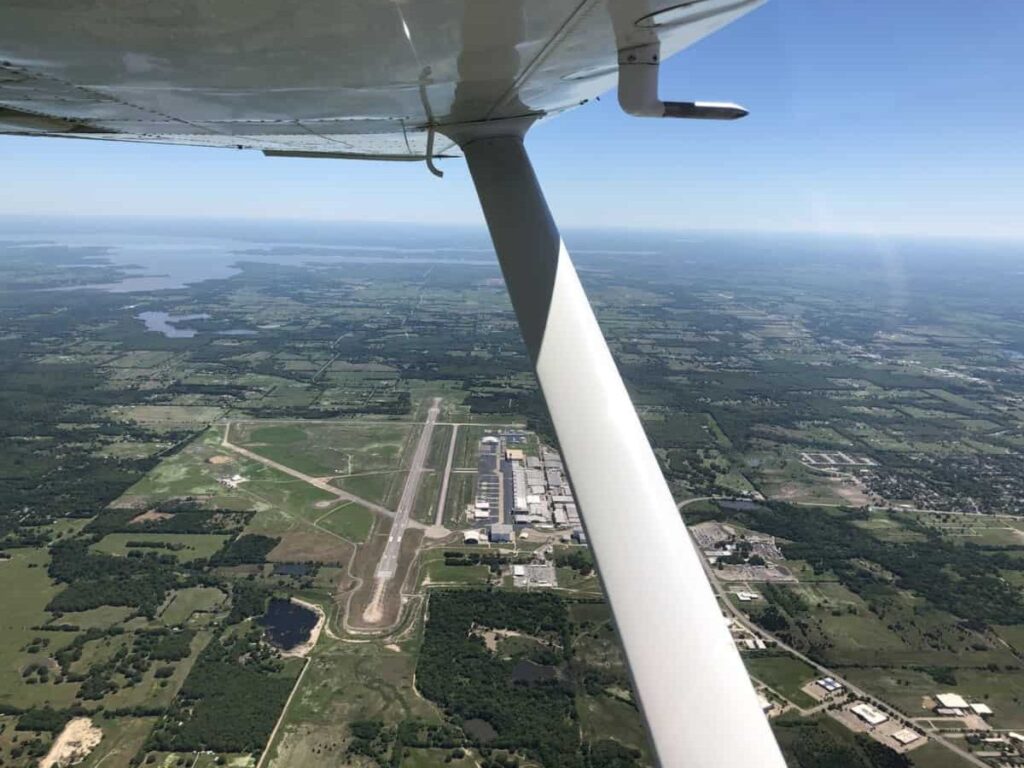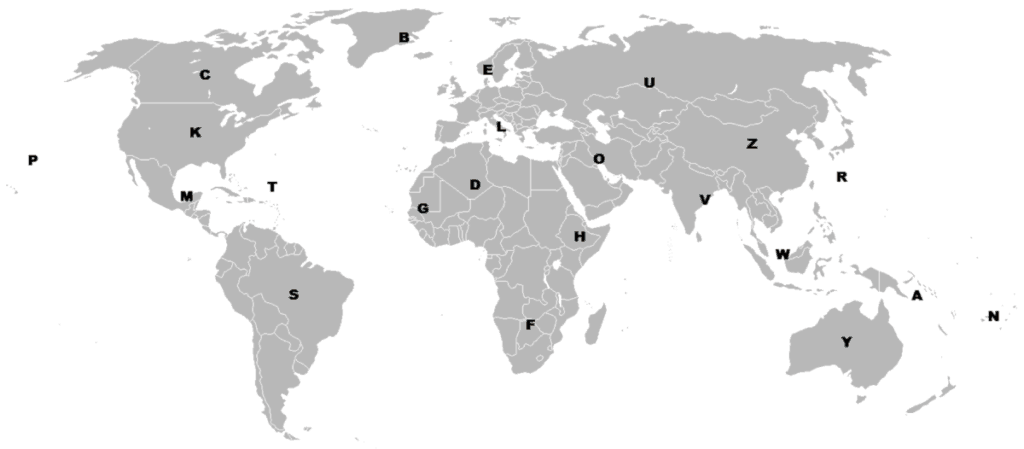
Airport identification codes are assigned according to a wide variety of standards, and in some cases, those standards even seem inconsistent. There are three letter / number codes, four letter / number codes, some that start with “K” (in the US) and those that don’t. Why do some airport identifiers begin with “K”?
The “K” identifier is for ICAO recognized airports that are located in the contiguous United States, though some smaller and privately-owned runways follow other naming conventions. ICAO and other international aviation authorities issue guidelines for the naming conventions for airports around the world.
There are some nuances to how airports are named, and at first glance it can appear that the only consistency is inconsistency. It will make more sense once you understand some the guidelines and “behind the scenes” of how airport identifiers are assigned.
How Does the ICAO Naming Convention Work?
Globally, the ICAO naming convention is based on a regional system. ICAO divides regions are generally divided into continents or countries depending on the local political and geographical boundaries. The naming convention follows according to the following:
- First Letter: Region
- Second Letter: Country
- Third Letter: Communication outlet identifier
- Fourth Letter: As desired or as available.
There are additional restrictions, rules, and guidelines designed to eliminate repetitive identifiers where all four letters are the same number. Of course, exceptions exist. For example, a Royal Airforce airbase in the Falkland Islands follows the conventions of airports in the United Kingdom, but the nearby commercial airport adheres to the South American conventions.
Refer to the table and map below for a list of regional identifiers.
| Prefix | Region |
| A | Western South Pacific |
| B | Greenland / Iceland / Kosovo |
| C | Canada |
| D | Eastern West Africa / Maghreb |
| E | Northern Europe |
| F | Central Africa / Southern Africa / Indian Ocean |
| G | Western West Africa / Maghreb |
| H | East Africa / Northeast Africa |
| K | Contiguous United States |
| L | Southern Europe / Israel / Turkey |
| M | Central America / Mexico / North and West Caribbean |
| N | Southern Pacific |
| O | Pakistan / Afghanistan / Middle East (excluding Cyprus Israel/ Turkey and Southern Caucasuses) |
| P | American North Pacific / Kiribati |
| R | Taiwan / South Korea / Philippines / Japan |
| S | South America |
| T | Eastern and Southern Caribbean |
| U | Russia / Post-Soviet States (excluding Baltic States and Moldova) |
| V | South Asia / Mainland Southeast Asia / Hong Kong / Macau |
| W | Maritime Southeast Asia (except Philippines) |
| Y | Australia |
| Z | Socialist East Asia |
Table 1: ICAO Regional Prefixes

Why Are Some US Airports Missing the “K” Prefix?
At the founding of the United Nations and the establishment of ICAO, U.S. Radio stations largely carried “K” prefixes, and these prefixes carried over to the airports served by many of these radio stations.
For U.S. airports, international recognition is a voluntary process; as such many smaller airports use only the three letter FAA identifier. ICAO registration allows for international flight planning and coordination. Local fields that see little or no international traffic thus do not need ICAO registration.
Ultimately the decision to register an airport with ICAO is a result of grandfathering in 1947, or a conscious choice by airport management.
The US has a much stronger, centralized aviation regulatory body in the FAA, resulting in little need for local fields to need ICAO registration.
For many nations and regions, ICAO becomes the de facto regulatory body for aviation infrastructure. These countries and regions rely on ICAO to establish and maintain airport standards and conventions. As a result certain regions have a higher proportion of ICAO registered airports.
How Do US Airports Receive Their Identifiers?
FAA document FAA JO 7350.9 governs the identification of airports, communication outlets, and navigational aids for the United States. This document lists the location and three or four-letter identifier for every official airport in the United States.
There is an FAA registration process outlined in the 7350.9 document that identifies the associated information required by the FAA to officially identify an airport.
Additionally, the FAA provides contact information to initiate the ICAO registration process for an airport. The required data includes information such as the airport name, city name, latitude and longitude, weather associated with the airport and more.
The FAA includes information in this document on naming conventions for airports that do not meet the requirements to be assigned an FAA three letter identifier (small privately-owned runways).
As an example, small private Kansas fields begin with an “SN” prefix, other states have similar prefixes assigned according to the table below. The ICAO companion to FAA JO 7350.9 is the 7910 document. It similarly lists all of the ICAO register airports in the world (unfortunately current versions of this document are expensive to obtain from ICAO).
| State | Prefix(s) |
| Alaska | AA |
| Arizona | AN |
| Arkansas | AS |
| California | CL, CN |
| Colorado | CD |
| Florida | FA, FD |
| Georgia | GE |
| Illinois | IS, LL |
| Indiana | IG, II |
| Kansas | SN |
| Kentucky | KY |
| Louisiana | LS |
| Minnesota | MY |
| Missouri | MU |
| Nevada | VE |
| New Jersey | JY |
| New York | NK |
| North Carolina | NR |
| North Dakota | NA |
| Ohio | OA, OI |
| Oklahoma | OL |
| Oregon | OG |
| Pennsylvania | PN, PS |
| Texas | TA, TE, TS, XA, XS, TT |
| Virginia | VG |
| Wisconsin | WN, WS |
| Washington | WT |
Table 2: FAA Supplemental Prefixes
Why Do Commercial Airlines Use Different Airport Codes Than “Normal” Pilots?
Some airports, particularly outside the United States, carry different identification codes when booking commercial air travel.
While the FAA and ICAO govern the identification conventions for use in flight plan filing and navigation, a separate industry organization, IATA (International Air Transportation Association) assigns separate identifiers for use by airlines and cargo carriers.
These codes are used to facilitate passenger and customer interactions with the aviation system.
IATA’s status as an industry organization alleviates some of the regulatory overhead required by ICAO and the FAA (and its equivalents). Thus, the codes assigned by IATA are often tied closely to city or airport colloquial names where radio communications standards allow.
Flight planning and navigational databases do not use these codes; they exist as a customer relations and industry standardization tool only. While many airports have overlapping IATA, FAA, and ICAO identifiers, it is the FAA and ICAO identifiers that are used by pilots, dispatchers and controllers.
Why Do Some Private Airfields Not Appear on Sectional Charts?
Talk to a local pilot familiar with the area, and it is likely he or she is aware of a host of small privately held airports that are not displayed on sectional charts. In my local area, a minimum of 7 such airports come to mind.
When identifying a runway to the FAA, the owner has the option to decline charting of the runway; often not charting an airport is tied to liability concerns.
State laws govern liability differently thus some states will show greater numbers of private airports than others. There is also an incentive to simply stay under the radar of the local pilot population.
Why Are Small Private Airports Identified By a “Common” Name and Not an Identifier?
In some areas, private fields are common enough that it is advantageous to simply save chart space on the sectional. Additionally local controllers are more familiar with colloquial terminology rather than identifiers. Additionally identifier conventions are less consistent for private fields and not publishing this information eliminated additional churn and tracking for the FAA.
Conclusion
Airport identifiers are governed by multiple regulatory bodies. The national body (the FAA) manages airport identifiers, but works in tandem with the international regulatory agency, ICAO, to standardize and formalize airport identification codes.
When governed by ICAO, airport identifiers adhere to regional and national naming conventions. For the contiguous United States, this is the “K” prefix, but the FAA gives airport owners and operators the option to not register with ICAO. This results in some airports, particularly small, non-commercial fields not carrying the leading “K” on their identifier.
Some airports also carry identifiers used by the airline and cargo industries to simplify customer service, but for pilots, the ICAO and or FAA identifier is the proper navigational and flight planning identifier to use.



